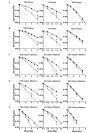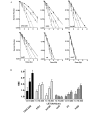Hyperthermia-induced radiosensitization in CHO wild-type, NHEJ repair mutant and HR repair mutant following proton and carbon-ion exposure
- PMID: 26722249
- PMCID: PMC4665357
- DOI: 10.3892/ol.2015.3732
Hyperthermia-induced radiosensitization in CHO wild-type, NHEJ repair mutant and HR repair mutant following proton and carbon-ion exposure
Abstract
The DNA repair mechanisms involved in hyperthermia-induced radiosensitization with proton and carbon ion radiation exposure were investigated in the present study. In a previous study, Chinese hamster ovary (CHO) cells were exposed to low linear energy transfer (LET) photon radiation. These cells can be sensitized by hyperthermia as a result of inhibition of homologous recombination (HR) repair. The present study used wild-type, non-homologous end joining (NHEJ) and HR repair-deficient CHO cells to define the contributions of each repair pathway to cellular lethality following hyperthermia-induced hadron radiation sensitization. The cells were exposed to ionizing radiation, followed by hyperthermia treatment (42.5°C for 1 h). Hyperthermia-induced radiosensitization was determined by the colony formation assay and thermal enhancement ratio. HR repair-deficient cells exhibited no hyper-sensitization to X-rays, protons, or low and high LET carbon ions when combined with hyperthermia. Wild-type and NHEJ repair-deficient cells exhibited significant hyperthermia-induced sensitization to low LET photon and hadron radiation. Hyperthermia-induced sensitization to high LET carbon-ion radiation was less than at low LET radiation. Relative biological effectiveness (RBE) between radiation alone and radiation combined with hyperthermia cell groups was not significantly different in any of the cell lines, with the exception of wild-type cells exposed to high LET radiation, which exhibited a lower RBE in the combined group. The present study investigated additional cell lines to confirm the lower RBE observed in DNA repair-deficient cell lines. These findings suggested that hyperthermia-induced hyper-sensitization to hadron radiation is also dependent on inhibition of HR repair, as was observed with photon radiation in a previous study.
Keywords: DNA repair; hadron radiation; hyperthermia.
Figures



Similar articles
-
Most DNA repair defects do not modify the relationship between relative biological effectiveness and linear energy transfer in CRISPR-edited cells.Med Phys. 2024 Jan;51(1):591-600. doi: 10.1002/mp.16764. Epub 2023 Sep 27. Med Phys. 2024. PMID: 37753877
-
DNA Repair Deficient Chinese Hamster Ovary Cells Exhibiting Differential Sensitivity to Charged Particle Radiation under Aerobic and Hypoxic Conditions.Int J Mol Sci. 2018 Jul 30;19(8):2228. doi: 10.3390/ijms19082228. Int J Mol Sci. 2018. PMID: 30061540 Free PMC article.
-
Repair of DNA damage induced by accelerated heavy ions in mammalian cells proficient and deficient in the non-homologous end-joining pathway.Radiat Res. 2006 Jan;165(1):59-67. doi: 10.1667/rr3489.1. Radiat Res. 2006. PMID: 16392963
-
DNA double strand break repair inhibition as a cause of heat radiosensitization: re-evaluation considering backup pathways of NHEJ.Int J Hyperthermia. 2008 Feb;24(1):17-29. doi: 10.1080/02656730701784782. Int J Hyperthermia. 2008. PMID: 18214766 Review.
-
Mechanism of radiosensitization by hyperthermia (> or = 43 degrees C) as derived from studies with DNA repair defective mutant cell lines.Int J Hyperthermia. 2004 Mar;20(2):131-9. doi: 10.1080/02656730310001627713. Int J Hyperthermia. 2004. PMID: 15195507 Review.
Cited by
-
Triggered radiosensitizer delivery using thermosensitive liposomes and hyperthermia improves efficacy of radiotherapy: An in vitro proof of concept study.PLoS One. 2018 Sep 18;13(9):e0204063. doi: 10.1371/journal.pone.0204063. eCollection 2018. PLoS One. 2018. PMID: 30226898 Free PMC article.
-
Enhanced radiosensitivity of head and neck cancer cells to proton therapy via hyperthermia-induced homologous recombination deficiency.Clin Transl Radiat Oncol. 2024 Dec 4;51:100898. doi: 10.1016/j.ctro.2024.100898. eCollection 2025 Mar. Clin Transl Radiat Oncol. 2024. PMID: 39720467 Free PMC article.
-
Progression in low-intensity ultrasound-induced tumor radiosensitization.Cancer Med. 2024 Jul;13(13):e7332. doi: 10.1002/cam4.7332. Cancer Med. 2024. PMID: 38967145 Free PMC article. Review.
-
Microscopic, Macroscopic and Thermal Impact of Argon Plasma, Diode Laser, and Electrocoagulation on Ovarian Tissue.In Vivo. 2023 Mar-Apr;37(2):531-538. doi: 10.21873/invivo.13111. In Vivo. 2023. PMID: 36881055 Free PMC article.
-
Hadron Therapy, Magnetic Nanoparticles and Hyperthermia: A Promising Combined Tool for Pancreatic Cancer Treatment.Nanomaterials (Basel). 2020 Sep 25;10(10):1919. doi: 10.3390/nano10101919. Nanomaterials (Basel). 2020. PMID: 32993001 Free PMC article.
References
LinkOut - more resources
Full Text Sources
Other Literature Sources
